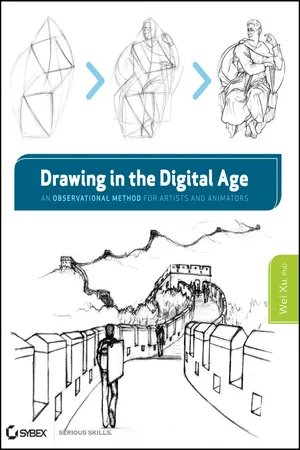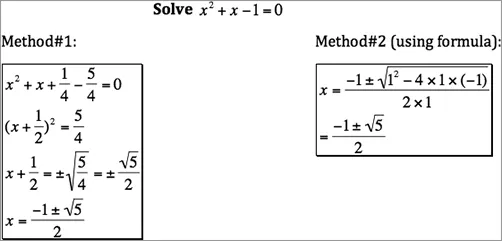
- English
- ePUB (mobile friendly)
- Available on iOS & Android
eBook - ePub
About this book
A solid foundation for improving your drawing skills
Teaching a new observational method based on math and computer graphics principles, this book offers an innovative approach that shows you how to use both sides of your brain to make drawing easier and more accurate. Author Wei Xu, PhD, walks you through his method, which consists of scientific theories and principles to deliver real-world techniques that will improve your drawing skills. Xu's pioneering approach offers a solid foundation for both traditional and CG artists.
- Encourages you to use both sides of your brain for drawing with the highest efficiency possible
- Introduces an innovative method invented by the author for improving your drawing skills
If you are eager to learn how to draw, then this book is a must read.
Frequently asked questions
Yes, you can cancel anytime from the Subscription tab in your account settings on the Perlego website. Your subscription will stay active until the end of your current billing period. Learn how to cancel your subscription.
At the moment all of our mobile-responsive ePub books are available to download via the app. Most of our PDFs are also available to download and we're working on making the final remaining ones downloadable now. Learn more here.
Perlego offers two plans: Essential and Complete
- Essential is ideal for learners and professionals who enjoy exploring a wide range of subjects. Access the Essential Library with 800,000+ trusted titles and best-sellers across business, personal growth, and the humanities. Includes unlimited reading time and Standard Read Aloud voice.
- Complete: Perfect for advanced learners and researchers needing full, unrestricted access. Unlock 1.4M+ books across hundreds of subjects, including academic and specialized titles. The Complete Plan also includes advanced features like Premium Read Aloud and Research Assistant.
We are an online textbook subscription service, where you can get access to an entire online library for less than the price of a single book per month. With over 1 million books across 1000+ topics, we’ve got you covered! Learn more here.
Look out for the read-aloud symbol on your next book to see if you can listen to it. The read-aloud tool reads text aloud for you, highlighting the text as it is being read. You can pause it, speed it up and slow it down. Learn more here.
Yes! You can use the Perlego app on both iOS or Android devices to read anytime, anywhere — even offline. Perfect for commutes or when you’re on the go.
Please note we cannot support devices running on iOS 13 and Android 7 or earlier. Learn more about using the app.
Please note we cannot support devices running on iOS 13 and Android 7 or earlier. Learn more about using the app.
Yes, you can access Drawing in the Digital Age by Wei Xu, Ph.D. in PDF and/or ePUB format, as well as other popular books in Computer Science & Computer Graphics. We have over one million books available in our catalogue for you to explore.
Information
Chapter 1
Understanding the Relationship between Math and Art
After a certain high level of technical skill is achieved, science and art tend to coalesce in esthetics, plasticity, and form.—Albert Einstein (1879–1955), scientist and artist
Math and fine art (or simply art) are two of the most interesting subjects to explore. However, their relationship may seem paradoxical. Unlike the bond of math and science, the association between math and art is not so obvious. The average person might have difficulty seeing any direct connection between math and art because of their distinct content and methodologies. Instead, the strict logic used in math and the emotional expressions portrayed in art might make the two subjects seem like polar opposites. Yet some experts think otherwise.
So, what is the truth? What are the differences and similarities between math and art? Are they really linked in any sense? If yes, how do they affect and help each other? This chapter provides answers to these questions. In order to lay the foundation for later introducing a new method of learning art, this chapter also focuses on the following topics:
- Ways that math can be used to help us learn about art
- Existing drawing methods and their connections with math
- Reasons that separating math from art is a serious mistake
Understanding How Math and Art Differ
Art and math are indeed very different in at least the following two aspects:
- In terms of content, math is an abstraction of patterns, whereas art is a visual product that provides aesthetic value.
- In terms of methodology, we must process everything in math sequentially by strictly following logic and proven rules. In art, the way we create and learn is subjective and empirical.
Differences in Content
Math and art exhibit distinct differences in their content. Math is the study of numbers, properties, and the relationships of quantities. Either a research paper or a student exercise (later referred to as “math work”) tries to show that some quantity patterns exist in a particular problem. Although math is abstract, it comes from and applies to almost everything: science, technology, economics, and even art.
Mathematics and Culture I, edited by Michele Emmer (Springer-Verlag, 2004), details some of these interconnections between math and other disciplines.
Art is a visual product that displays graphics appealing to an audience and the artist. An artwork may originate from real scenes, but it is most influenced by the artist’s emotions and senses.
A math work involves a sequence of logic operations that delivers results by using theories, symbols, and established procedures. Math concepts may be fully abstract and imaginary, as they are not necessarily associated with any real objects in the physical world. Such abstractness allows math to be used as a language to describe and solve problems in science and engineering. Math integrates a strong sense of correct or incorrect. Its content is objective—that is, a math work has the same meaning across all cultures at all times. The purpose of math work is either to develop a new theory for future use or to solve a problem based on existing theories. In math circles, a new math research article is accepted only if it presents new results and is proven to be correct by experts. Otherwise, showing the article to the public would be almost meaningless, even if the work were done by a famous mathematician.
In contrast, a piece of artwork, either two-dimensional (2D) or three-dimensional (3D), presents visual structures that express an artist’s thoughts or represent objects the artist observed or imagined. By using shapes, colors, textures, and patterns, artists intend to communicate with viewers in a graphic language that is easy to understand. Artwork is subjective. Generally speaking, the content carries no sense of right or wrong, provided that the artwork does not go against its cultural standard. Any work completed by an artist can be exhibited to the public as long as the artist is satisfied with the product. Visitors in an art gallery can be quickly drawn into imaginary worlds presented by artists. These viewers have emotional reactions to a painting or object based on their individual experiences that they associate with the contents of the artwork. Artwork will never provide everyone with the same experience because its meaning is rooted deeply in each viewer’s culture and personal history.
Differences in Methodologies
The methodologies used in math and art are quite different too. In math, every step has to be processed sequentially by following logic and proven theories without emotion. Although mathematicians may use their wildest imaginations when solving a problem or coming up with a new concept, all of their thoughts must rely on reasoning and proven results. After a problem is solved or a new theory is conceived, the outcome then becomes a stepping-stone for future work, and the best approach to achieve such results may be standardized for others’ use. This procedural mechanism makes math easy to learn.
For a math problem, even when there are multiple ways to solve it, the correct answer will be the same no matter which method you use. The key to learning math is to understand its theories and related processes. A math work is about definitions, principles, and logic operations. After the process is understood, anyone can duplicate the entire work perfectly without errors—but without understanding, you could easily get stuck at any step. That is why most of us can master basic math knowledge and operations in school.
Figure 1-1 shows a simple algebra problem—solving a quadratic equation—that can be worked out in two ways. The first method turns the equation into a special form so that the square root can be removed in order to solve the problem. The process requires careful manipulation of the numbers. A mistake at any point would result in a wrong answer. However, mathematicians have already articulated these tedious steps and come up with a standard formula for solving any quadratic equation. The second method involves applying that formula directly, resulting in fewer steps and therefore less hassle.

Figure 1-1: An example of a math problem solved in two ways
In contrast, the method we use to study and create art is subjective and experimental. The process of creating art is affected by the artist’s opinions on the topics and that individual’s skills in using particular art tools; thus, artwork is hard to reproduce exactly. Although students are taught theories and principles in art class, in order to turn the theories into real skills, students have to spend most of their time doing hands-on exercises to apply those theories and to master the actual skills of using pens, brushes, and other media. Because of human physical limitations, no one can draw a perfect line or circle, let alone a complicated object, even if the drawing principles are understood. Figure 1-2 shows an observational drawing exercise. Although it is quite simple, drawing the object perfectly is extremely hard, even for experienced artists. In creating a piece of art, art...
Table of contents
- Cover
- Table of Contents
- Title
- Copyright
- Publisher’s Note
- Dedication
- Acknowledgments
- About the Author
- Introduction
- Chapter 1: Understanding the Relationship between Math and Art
- Chapter 2: Extracting Graphical Structures—A Scientific Point of View
- Chapter 3: Drawing with the ABC Method
- Chapter 4: Drawing Simple Objects
- Chapter 5: Drawing Complicated Objects
- Chapter 6: Drawing Complicated Scenes
- Chapter 7: Using Advanced Techniques
- Chapter 8: Using Special Techniques for Drawing Human Bodies
- Index
- End User License Agreement